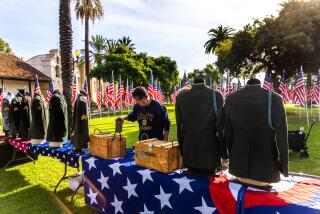Recalling Wartime on Home Front : History: Exhibit looks back on local life 50 years ago, when the city was united in patriotic effort.
- Share via
SANTA PAULA — In the winters of his high school years, Santa Paula resident Don Olivier would get up at 3:30 a.m. and hurry to citrus orchards in the Santa Clara Valley.
*
There, he and his classmates would light oil smudge pots to heat the orchards and keep the fruit from freezing, he said.
By 7:30 a.m., still wearing their work clothes, the young boys would hit the classroom.
That was more than 50 years ago, when the United States was immersed in World War II and most of the men in the small farm community of Santa Paula were serving in the military.
“Everyone was gung-ho about helping those in the war,” said Olivier, 67. “As young boys, we felt it was our responsibility to carry on the work of the men who had been drafted to go to war.”
Olivier is one of about 25 people who donated items to an exhibit at the Santa Paula Union Oil Museum on wartime experiences at a local level, said John Nichols, one of the two curators putting the exhibit together.
“We want to provide a picture of what life was like here at home,” said Nichols, who spent six months collecting objects from local residents.
The exhibit, called “Homefront Santa Paula,” will be at the museum until Sept. 10, Nichols said.
The exhibit coincides with the anniversary of the end of World War II. Fifty years ago Sunday, the United States bombed Hiroshima. Japan surrendered eight days later, on Aug. 14, 1945.
High school annuals, posters, letters and newspaper clippings tell the story of how the town came together in collecting metal and tires that would later be used in war affairs.
Several ration books illustrate the food shortages during World War II. Families received ration stamps to buy such items as meat, milk, sugar and canned goods.
Black-and-white photographs of some of the 30 Santa Paula residents who died in the war are also displayed in the exhibit.
A newspaper clipping says that Isabel Vela Prieto, a high school senior, was the first Santa Paula resident to be drafted during the third national draft.
*
Another news clipping later reported that Vela Prieto, who had been trained to handle amphibious equipment for the Marines, was killed in action in the Pacific theater.
“When a family was notified about a loved one being killed, the entire town would mourn with them,” said Olivier.
Olivier was just starting high school when the war began raging in Europe and the Pacific.
As the men of the town enlisted in the military, young boys and girls would take over some of the duties of those who had left, Olivier said.
Every day after school during the harvest season, youngsters would hit the Santa Clara Valley by bicycle or bus. They were paid 45 cents an hour to pick oranges, lemons and walnuts--a common crop in the area during the war, he said.
“All of us in high school wanted to contribute to the war. We wanted to do something that would help the men out there,” Olivier said. “No one had very much, but everyone was happy with what they had.”
Santa Paula native Beverly Hardening, 66, said life was quite different than it is today.
*
Because of a shortage of nylon stockings and makeup, girls would combine powdered tea and water to create a paste they would use as leg and face makeup, Hardening said.
“We had to learn to improvise for everything,” she said, “including who we dated.”
Because of a shortage of males in the senior class, for three consecutive years, servicemen from the Port Hueneme Navy base were invited to the high school proms to act as blind dates.
But the senior prom of 1944 was canceled because not even servicemen were available, Hardening said.
Olivier, now a retired bank employee who served in the Korean War, said he is grateful for his World War II experience at home.
“I learned that I could do hard physical work and that it wasn’t bad for me,” Olivier said. “And I learned to appreciate life at an early age.”
More to Read
Sign up for Essential California
The most important California stories and recommendations in your inbox every morning.
You may occasionally receive promotional content from the Los Angeles Times.













